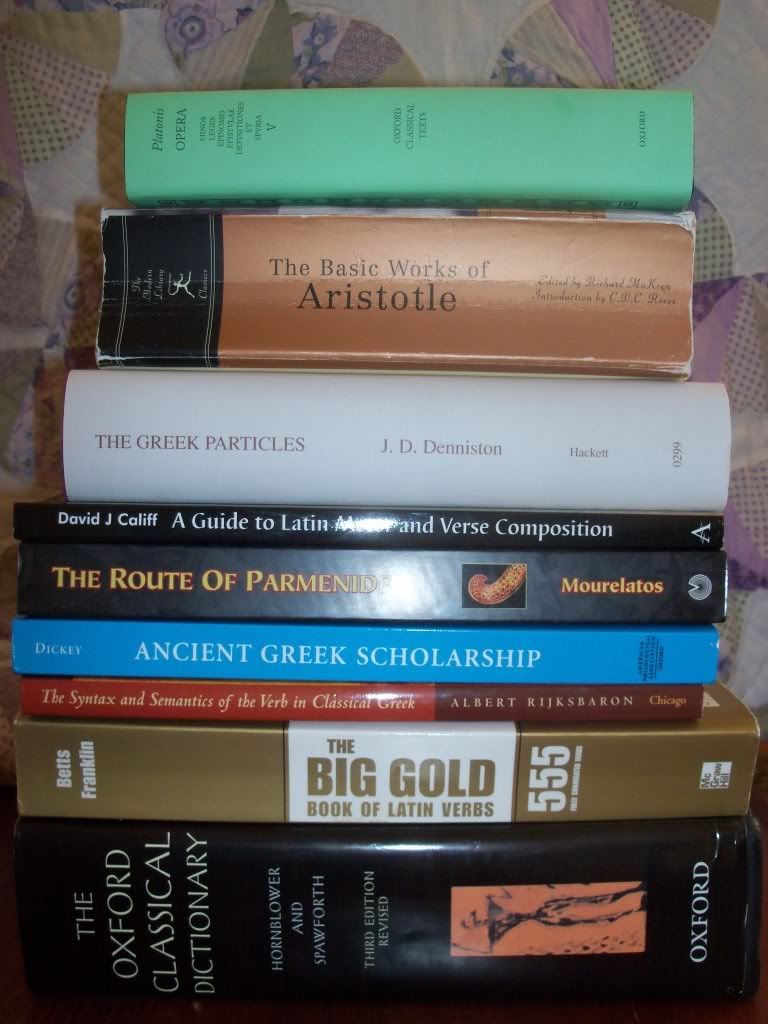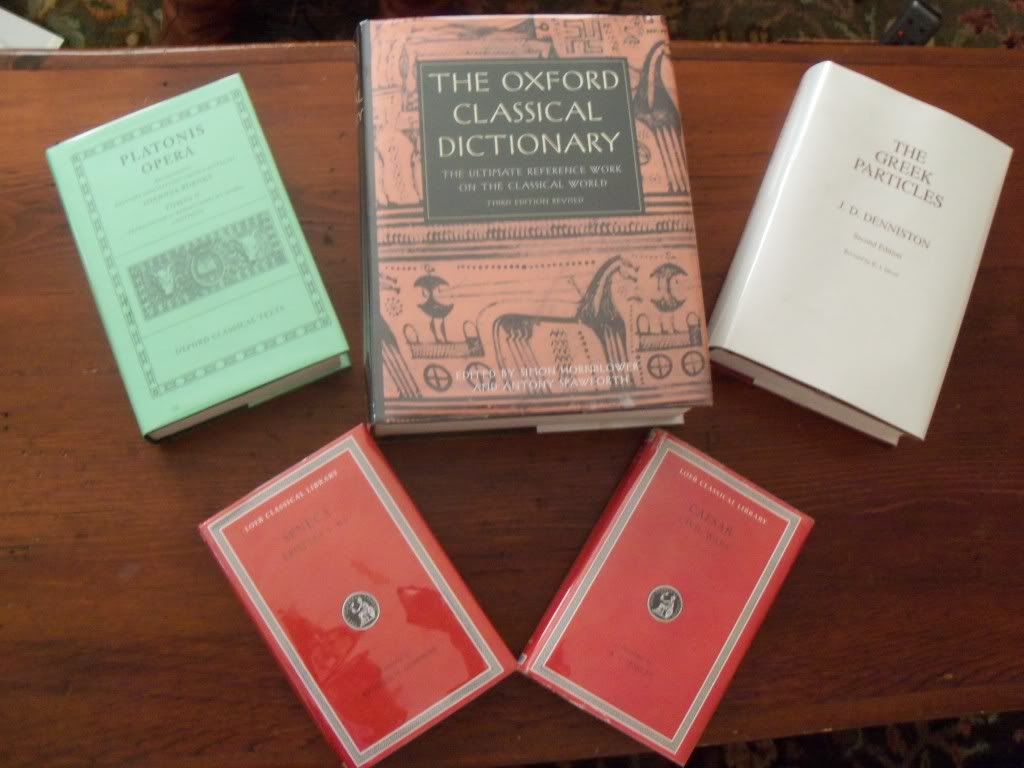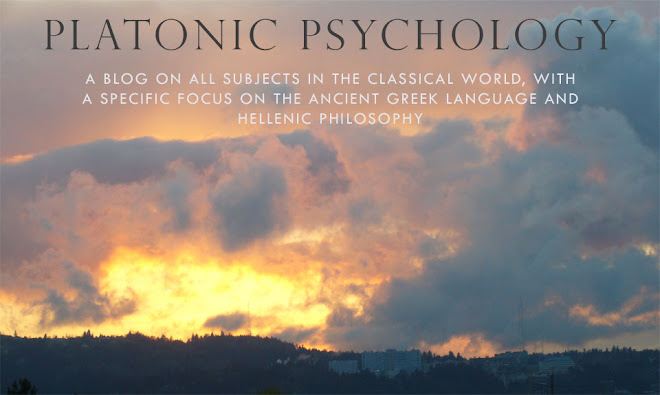For any of you out there who, like me, are reviewing your Ancient Greek grammar for fall classes, I have found an interesting resource. Somebody posted a set of Ancient Greek paradigms for nouns, pronouns, adjectives, and verbs on Berkeley's old Socrates server. Enjoy.
Also, because I have a lot to do before the summer ends, I am postponing my reworkings of "Dates in the Platonic Corpus" until after September 8th.
Tuesday, August 30, 2011
Saturday, August 27, 2011
Appeitive: The Original Windy City
Propertius II and I finally finished reading Iliad Book 13 this morning, mostly due to my slowness and brief interruptions where each of us were busy. I have to say, I really enjoyed the process of reading Homer in the original. I know I confessed in a previous blogpost that I did not like Homer, but the Iliad has grown on me more and more since we began three months ago (for reference, we have also been reading plato beside the Homer and taking time off). We start Book 14 this coming week after some work on the Crito
has grown on me more and more since we began three months ago (for reference, we have also been reading plato beside the Homer and taking time off). We start Book 14 this coming week after some work on the Crito .
.
One of the many things that I noticed in our most recent trek through the Iliad , was epithets. When reading 130 lines over two sittings, I became familiar with certain epithets often used: great-hearted (μεγάθυμος), godlike (δῖος), lord (ἄωαξ), etc. The end of Book 13 focuses on the Trojans, so there were many references to Troy (Ilion) which also bore epithets. My favorite was "Ἴλιον ἠωεμόεσσαν" (Iliad 13.724) or "windy Ilion." It amused me that Troy was the original windy city.
, was epithets. When reading 130 lines over two sittings, I became familiar with certain epithets often used: great-hearted (μεγάθυμος), godlike (δῖος), lord (ἄωαξ), etc. The end of Book 13 focuses on the Trojans, so there were many references to Troy (Ilion) which also bore epithets. My favorite was "Ἴλιον ἠωεμόεσσαν" (Iliad 13.724) or "windy Ilion." It amused me that Troy was the original windy city.
One of the many things that I noticed in our most recent trek through the Iliad
Friday, August 26, 2011
Appetitive/Reasoning: The Mystery of the Propylaea
 |
| Picture Credit: Wikimedia Commons {{PD-1923}} |
 |
| Photocredit: Cerinthus |
| Photocredit: Wikimedia Commons |
The truth is, we don't know. Some scholars suggested that it was due to lack of funds from the Peloponnesian War that the Propylaea was never finished, but Jeffrey Hurwit convincingly argues that "frugality does not explain why the finishing touches were not applied to the Propylaia later. A city that could in 434/3 allot 20 talents a year to get the Acropolis in shape (one of the provisions of the Kallias Decrees) and that in the last third of the fifth century could afford to complete the Erechtheion and Nike sanctuary and create the Nike parapet could surley have afforded to return of the gateway and shave off a few unsightly lumps of stone from its walls" (Hurwit
Hurwit and my professor both contended that the Propylaea, being a secular structure, did not merit the same attention, especially during hard times like the Peloponnesian War, and hence it was abandoned for more more important sacred buildings (Hurwit
Tuesday, August 23, 2011
Appeitive/Reasoing: Ancient Greek Death Monuments
I found a website today that I really wish I had discovered while writing my thesis. It's only got basic information, but it shows a nice trajectory of changing death monuments from the Geometric to the Hellenistic period. It is accompanied by a collection of short essays on each period. Check out this piece on the Metropolitan Museum of Art's website.
Friday, August 19, 2011
Appetitive: Birthday Books
 |
| Birthday Books |
 |
| Covered books |
Tuesday, August 16, 2011
Appetitive/Reasoning: Reviews and Things to Come
I've got a cold so I have not been as productive as I might have been. I am still in the process of working on some of my arguments on Plato which should appear at the end of the week sometime. The first one will be trying to dispute the conception of Socrates (the character) as a mouthpiece for Plato's philosophy. I also should be posting some Catullus and maybe some Horace.
In the meantime, I have written a review (thus far) of the a new book that just came out: David Schaps' Handbook for Classical Research . It is on Fragments of Sulpicia.
. It is on Fragments of Sulpicia.
In the meantime, I have written a review (thus far) of the a new book that just came out: David Schaps' Handbook for Classical Research
Saturday, August 13, 2011
Appetitive: Praise with Homeric Terms
Back in the early days of my freshman Mediterranean humanities course, my classmates and I replaced common words for praise (like "kudos") with the Greek word τιμή (esteem, honor) which is so important in the Homeric epics. So instead of saying "awesome job" we would say silly things like "mad τιμή."
As I was reading Homer this morning, I happened upon the word κῦδος. This really surprised me because we all replaced "kudos" with the Greek, but it turns out κῦδος is a similar word to τιμή as it means "glory" or "renown."
this morning, I happened upon the word κῦδος. This really surprised me because we all replaced "kudos" with the Greek, but it turns out κῦδος is a similar word to τιμή as it means "glory" or "renown."
Note: I have been working hard on some research on the Laws and I am planning on retelling the argument from my "Dates in the Platonic Corpus" series in a clearer fashion over the next few weeks as I work on editing my thesis. I do not think that I did justice to either the persuasive power of the Zuckert argument or the complexities of dating the Laws. I shall attempt to do a better job this time around.
and I am planning on retelling the argument from my "Dates in the Platonic Corpus" series in a clearer fashion over the next few weeks as I work on editing my thesis. I do not think that I did justice to either the persuasive power of the Zuckert argument or the complexities of dating the Laws. I shall attempt to do a better job this time around.
As I was reading Homer
Note: I have been working hard on some research on the Laws
Thursday, August 11, 2011
Reasoning: The Landscape of Memory on the Acropolis
 |
| Photocredit: Cerinthus |
One of the textbooks for my Art History class, The Acropolis in the Age of Pericles
For example, in the chapter "Landscape of Memory on the Acropolis," which for me has been the high point of the book thus far (I am about halfway through), discussed the way that the architects of the Periclean Acropolis preserved and highlighted the history of both Athens and more specifically the acropolis. There still remain so-called Cyclopean walls (walls made of large limestone boulders which have the cracks between them filled in by smaller stones [2]) from the Bronze Age (presumably a Bronze Age Palace) which were given a place of honor rather than dismatled or hidden by the more regular and precise-looking classical walls (Hurwit
It was not just the Bronze Age architecture that the Classical Athenian builders monumentalized; many Archaic structures were incorporated into their classical counterparts. This was particularly important to the Athenians because Xerxes sacked the Archaic Acropolis when he invaded Athens and destroyed not only the standing temples and shrines but also the so-called Older Parthenon which was under construction at the time. Pericles' plan for the classical Parthenon used some of the metopes and columns of the Older Parthenon and some of the foundations became a Persian War Memorial (Hurwit
Further incorporating Archaic predecessors, "the Erechtheion ...was not so much a temple as it was a composition of many shrines" (Hurwit
 |
| Photocredit: Cerinthus |
Endnotes:
- Walking the other day, I was thinking to myself how often I am harshly critical of textbooks and scholarly work and I was wondering whether I was becoming an arrogant curmudgeon. However, I remembered reading this book that my vehemence in the praise of scholarship I like is of the same degree of my criticism of those texts I find lacking. I am not sure if this ameliorates my harshness in any way, but at least it makes me feel slightly more balanced.
- Cyclopean walls were named thus because later Greeks thought the boulders in the Bronze Age walls were so big they must have been placed there by Cyclopes.
Tuesday, August 9, 2011
Appetitive: Theoi
I was going to go into a long discussion about how much I love my art history textbook (Jeffrey Hurwit's The Acropolis in the Age of Pericles ), but that will have to wait until tomorrow. My art history professor directed us to an amazing website called Theoi which is a source for myth in Ancient Greece and Rome. But what a source! It not only provides the myth and encyclopedia type entries, but also provides English translations (not great ones, but sufficient) of the primary source material relating to the mythology. I highly recommend it.
), but that will have to wait until tomorrow. My art history professor directed us to an amazing website called Theoi which is a source for myth in Ancient Greece and Rome. But what a source! It not only provides the myth and encyclopedia type entries, but also provides English translations (not great ones, but sufficient) of the primary source material relating to the mythology. I highly recommend it.
Sunday, August 7, 2011
Reasoning/Appetitive: The Parthenon Frieze
I have now read three different interpretations of the Parthenon Frieze for my art history classes next week: J.J. Politt's (Art and Experience in Classical Greece ), Joan Connelly's ("Parthenon and Parthenoi: A Mythological Interpretatin fo the Parthenon Frieze"), and Jenifer Neil's (The Parthenon Frieze
), Joan Connelly's ("Parthenon and Parthenoi: A Mythological Interpretatin fo the Parthenon Frieze"), and Jenifer Neil's (The Parthenon Frieze , Chapter 6). I found it very difficult to chose between any of their claims on the evidence given. Not one of the three shows a complete picture or even a complete sketch of the frieze. So, I happened upon this website made by someone at Columbia (which, amusingly enough I posted on my blog in March). The website allows the viewer to scroll through and see the frieze in it's entirety as well as view famous pieces up close. Enjoy!
, Chapter 6). I found it very difficult to chose between any of their claims on the evidence given. Not one of the three shows a complete picture or even a complete sketch of the frieze. So, I happened upon this website made by someone at Columbia (which, amusingly enough I posted on my blog in March). The website allows the viewer to scroll through and see the frieze in it's entirety as well as view famous pieces up close. Enjoy!
Saturday, August 6, 2011
Reasoning/Appetitive: The Temple of Zeus at Olympia and Thoughts on Art History
 |
| Photocredit: Cerinthus |
When I was in the Greece and Rome survey that I took freshman year in college, the art history days were usually my least favorite. The art was fine, but my conference was lead by a philosophy professor and there was not a single art history student in my class. Furthermore, the art history textbooks were really boring, and almost no one wanted to read them. The only great discussion we had was when we discussed the Parthenon, because we read a more interesting (and I believe slightly controversial) article called "Parthenon and Parthenoi: A Mythological Interpretatin fo the Parthenon Frieze" by Joan Connelly. One of the textbooks for this class, Art and Experience in Classical Greece
The lectures themselves are better in this class than they were in the introductory class at my Alma Mater (see previous blogpost), but to be fair, they are two hours instead of 50 minutes and the class is concentrating solely on the art and its context. One of the best parts of the lectures is discussion of how the pieces were constructed. My professor actually discusses the artistic methodology in depth for (thus far) marble sculptures, bronze sculptures, and Attic black and red figure vases. I thought the black on the vases was paint that was essentially polished [1], but in reality the black is a watery slip that is painted over the piece and turns black and glass-like when fired at very high temperatures (the process heats it at various times between 800-950 degrees C).
The Temple of Zeus at Olympia: The article we were assigned was "Early Classical Architectural Sculpture: The Temple of Zeus at Olympia" in An Introduction to Greek Art
My favorite part of the text was the section on the metopes [3]. The metopes over the porches (the ones under the pediment were left blank) depicted the labors of Herakles. Although there are many stories associated with the hero, the number of metopes (6 on each side) restricted the number of scenes. These are the canonical twelve labors of Herakles depicted by most mythology books, but according to Woodford, "it is probably...that they were first assamebled as a group for the metopes at Olympia, for in their earlier history they varied greatly" (Woodford
 |
| Photocredit: Cerinthus |
1. In high school in my "archaeology" class (which was vaguely a Greek art history class) we had to make tiles to show us the difference in the difficulty level of black figure and red figure vases. I picked the Amphora by Exekias depicted Ajax and Achilles playing a game. I really love this vase. We used a stone to polish the image before firing, but I think I was so worried about chipping the paint that I didn't do a good job with the polishing:
This is the original image from the vase:
| Picturecredit: Wikimedia Commons. |
3. A metope is a square or rectangular image interspersed with triglyphs (usually a vertical geometric pattern) underneath the pediment on a temple.
Subscribe to:
Posts (Atom)
